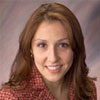Alumna Profile: Fabrisia Ambrosio Combines Passions for Physical Therapy and Regenerative Medicine
December 2, 2013
 Fabrisia Ambrosio, PhD sometimes pauses when she is introduced as a graduate of MCP Hahnemann University’s Physical Therapy Program. Although we recognize her as one of our astounding Drexel graduates, her Curriculum Vitae, website biography and countless presentation and lecture introductions still include the MCP Hahnemann name. Ambrosio is beginning to identify with Drexel more as time goes on, and that has a lot to do with the fact that Drexel is well-recognized. “It’s a university that everyone knows and respects,” she explained. At the time when she attended what was then the MCP Hahnemann Physical Therapy Program, the institution was ranked very highly and she also enjoyed the name recognition that Drexel’s predecessor had in the academic community. Today, we proudly celebrate Ambrosio and many other talented graduates from our predecessor institutions as our own.
Fabrisia Ambrosio, PhD sometimes pauses when she is introduced as a graduate of MCP Hahnemann University’s Physical Therapy Program. Although we recognize her as one of our astounding Drexel graduates, her Curriculum Vitae, website biography and countless presentation and lecture introductions still include the MCP Hahnemann name. Ambrosio is beginning to identify with Drexel more as time goes on, and that has a lot to do with the fact that Drexel is well-recognized. “It’s a university that everyone knows and respects,” she explained. At the time when she attended what was then the MCP Hahnemann Physical Therapy Program, the institution was ranked very highly and she also enjoyed the name recognition that Drexel’s predecessor had in the academic community. Today, we proudly celebrate Ambrosio and many other talented graduates from our predecessor institutions as our own.
Even throughout her Physical Therapy education, Ambrosio knew that she wanted to dedicate her career mostly to game-changing research. “I went to PT school because I thought it was a great way to gain in-depth knowledge about basic sciences such as anatomy, neurology and physiology, as well as about evaluations and treatment interventions. However, I always had research as my ultimate goal,” Ambrosio explained. She has established herself as a leader in regenerative medicine research. She not only has a Master of Physical Therapy degree from Drexel, but also a Master of Science degree in Physiology-Endocrinology from Laval University in Québec City, Québec, as well as a PhD in Rehabilitation Science & Technology from the University of Pittsburgh, where she now performs research. Her doctoral work involved the investigation of assistive technologies to preserve strength declines and minimize fatigue limitations for patients with Multiple Sclerosis (MS). When she finished her PhD, Ambrosio wanted to combine her backgrounds, ranging from the basic science to the rehabilitation to the clinical research.
In 2005, she accepted a faculty position in the Department of Physical Medicine & Rehabilitation at the University of Pittsburgh, though she also holds appointments in the Departments of Physical Therapy, Orthopaedic Surgery, and Microbiology & Molecular Genetics. She is additionally a faculty member at the University’s McGowan Institute for Regenerative Medicine.
“After graduating with my PhD, I was thrilled to be offered a faculty position within the Stem Cell Research Center at the University of Pittsburgh,” she went on. “That was diving into a new area for me, since I had no background in regenerative medicine at that point. However, I had many questions.” She started down a line of research, with funding from several foundational grants, to see how rehabilitation approaches could interface with regenerative medicine technologies for the development of exciting, cutting-edge therapies.
More recently, Ambrosio’s research has expanded into new territory. Several of her investigations explore how we can refine rehabilitation protocols to make them more effective at promoting the intrinsic healing capacity of our bodies, from the molecular to the cellular to the tissue levels. “It’s been an exciting line of inquiry,” Ambrosio said as she described an emerging concept in her research. Her work suggests that neuromuscular electrical stimulation, a common rehabilitation modality, may be used to promote stem cell functioning. Ambrosio’s research proves that we can introduce a kind of stem cell therapy even without transplantation. “Our preliminary findings suggest that we can kind of 'rehabilitate' our cells to make them more active and more efficient,” she explained. One model that Ambrosio and her team are turning to is aging. As humans age, their stem cell activity declines. “We believe that rehabilitation protocols may be used to modulate and rejuvenate the stem cells’ capacity to regenerate tissue,” Ambrosio said.
Prior to looking at aging, Ambrosio’s group first focused on children with Duchenne muscular dystrophy. Stem cells were transplanted to form new muscle fibers, enhancing subjects’ strength. Ambrosio published a paper on this study just earlier this year.
Ambrosio’s ultimate goal is to establish and provide evidence for the establishment of regenerative rehabilitation principles; that is, synergizing regenerative medicine and rehabilitation approaches in order to optimize functional outcomes. “Regenerative medicine interventions are increasingly marking their way into the clinic. As they do, an exciting new population of patients who will be requiring physical therapy will emerge. I believe the time is right to begin thinking about how our rehabilitation protocols can be used to maximize the efficiency of these cutting-edge technologies,” Ambrosio said. Her employer shares Ambrosio’s enthusiasm for regenerative rehabilitation; The University of Pittsburgh started an annual symposium series on regenerative rehabilitation three years ago. Since its inception, the symposium has started partnering with Stanford University, the University of California San Francisco, Emory University, and others. “I think it speaks to the enthusiasm and potential for the field of regenerative rehabilitation,” Ambrosio concluded.